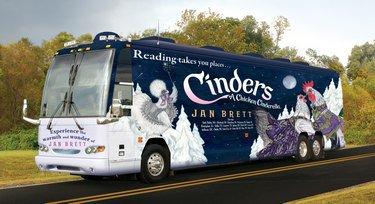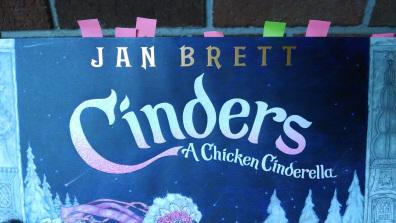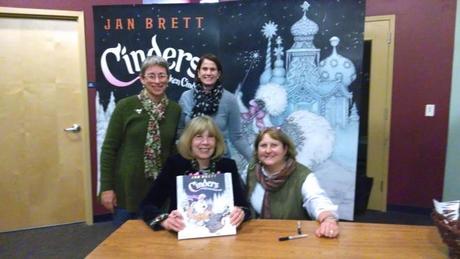Yesterday I sat down with Jan Brett to conduct my interview – in the living room – of her tour bus. I haven’t written up the article yet, so I can’t talk about everything, but can share a few details.

Once Jan knew that I spoke “chicken talk” she and I talked about chickens the entire time which was fine for me, because I didn’t want to ask the usual interview questions:
- How long does it take to make an illustration? – about one hour
- How long does it take to complete a book? – about one year.
- What was the inspiration for your book? She and her editor were talking about chickens molting one day and at the same time, they both compared molting (and looking bedraggled) to the story of Cinderella (who at the end turns into a princess.)
See? I didn’t need to ask those questions because if you do your research for the interview, you’d quickly find out that *everyone* asks the same questions and I already knew the answers because she had (patiently) given the answers again and again.
So I did a different kind of research. I poured through the pictures of her book and I noticed a few things.

For one, the fairy Godmother (a beautiful white silkie) used mice as the footmen for the carriage – in real life a mouse wouldn’t last more than a few minutes near a chicken, even if there was the promise of going to a wonderful ball. I wondered if I should relate to Jan our personal experience with finding a nest of baby mice in the bedding of the hen `house and what had happened to the mice (within minutes of being found), but then I decided, nope, let’s keep this interview a little more on the positive side.
Instead I asked her about chicken combs.
In her book, I had found examples of single, buttercup, strawberry, walnut, and rose combs. Along with being anatomically correct with regard to the combs, she even included details like the turquoise earlobes of a silkie. Jan’s book can teach you so much about chickens, as well as entertain.
Jan also told me that she was careful about using chicken breeds that only laid brown eggs, except of course for her “Cinders” (a Phoenix female) who lays the white egg which helps her to get identified by the handsome Prince.
I mean who pays that kind of attention to each very specific aspect of chicken anatomy?
Someone who obviously loves and cares for her chickens, that’s who.
Jan told me that because her book takes place in the 1800’s in Russia she used European birds only. She included breeds like Belgian Beadered d’Uccle, Cochin, Campine, and (of course) White-crested Polish. Getting more and more excited about the different breeds pictured, she told me that one of the things she loved most about chickens was the colors and patterns of the feathers.
“My drawings don’t even come close to doing them justice,” she sincerely told me.
At which point, my respect for her and her talent grew even more. To be so humble about a magnificent gift like the one she has for art and storytelling makes that gift even greater.
We talked about raising chickens and she talked about her experiences showing her birds (White-crested Black Polish.) She explained about taping up the top feathers when the birds have been pecked by others (in the same manner that owners of Maltese dogs tie up the dog’s hair) in order to protect the “look.”
And she also explained the layout of her henhouses (one for the hens, one – soundproofed – for the cockerels) where her birds are always protected in a fenced, roofed enclosure unless she’s out there to hensit, at which point, the flock is allowed to free range.
“So many people are excited about your chicken book,” I told her. “People are excited that you’ve shown chickens with personalities and as the works of art that they are. You must write another chicken book,” I begged. “Perhaps the next one can be Rhode Island Red Riding Hood.
There is so much more that I can and will write about Jan Brett, suffice it for now to say that if you like chickens, you will be absolutely enchanted by the grace and art of Cinders – A Chicken Cinderella.

(L – R) Terry Golson of Hencam, Melissa Caughey of Tilly’s Nest, Wendy Thomas, and Jan Brett
***
Wendy Thomas writes about the lessons learned while raising children and chickens in New Hampshire. Contact her at [email protected]
Also, join me on Facebook to find out more about the flock (children and chickens) and see some pretty funny chicken jokes, photos of tiny houses, and even a recipe or two.
Like what you read here? Consider subscribing to this blog so that you’ll never miss a post. And feel free to share with those who may need a little chicken love.

